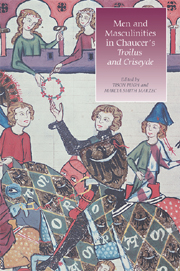Book contents
- Frontmatter
- Contents
- Contributors
- Abbreviations
- Introduction: The Myths of Masculinity in Chaucer's Troilus and Criseyde
- 1 “Beautiful as Troilus”: Richard II, Chaucer's Troilus, and Figures of (Un)Masculinity
- 2 The State of Exception and Sovereign Masculinity in Troilus and Criseyde
- 3 Revisiting Troilus's Faint
- 4 What Makes a Man? Troilus, Hector, and the Masculinities of Courtly love
- 5 Masculinity and Its Hydraulic Semiotics in Chaucer's Troilus and Criseyde
- 6 Masochism, Masculinity, and the Pleasures of Troilus
- 7 “The Dreams in Which I'm Dying”: Sublimation and Unstable Masculinities in Troilus and Criseyde
- 8 “A Mannes Game”: Criseyde's Masculinity in Troilus and Criseyde
- 9 Troilus's Gaze and the Collapse of Masculinity in Romance
- 10 Sutured Looks and Homoeroticism: Reading Troilus and Pandarus Cinematically
- 11 Being a Man in Piers Plowman and Troilus and Criseyde
- 12 “The Monstruosity in Love”: Sexual Division in Chaucer and Shakespeare
- Index
- CHAUCER STUDIES
9 - Troilus's Gaze and the Collapse of Masculinity in Romance
Published online by Cambridge University Press: 12 September 2012
- Frontmatter
- Contents
- Contributors
- Abbreviations
- Introduction: The Myths of Masculinity in Chaucer's Troilus and Criseyde
- 1 “Beautiful as Troilus”: Richard II, Chaucer's Troilus, and Figures of (Un)Masculinity
- 2 The State of Exception and Sovereign Masculinity in Troilus and Criseyde
- 3 Revisiting Troilus's Faint
- 4 What Makes a Man? Troilus, Hector, and the Masculinities of Courtly love
- 5 Masculinity and Its Hydraulic Semiotics in Chaucer's Troilus and Criseyde
- 6 Masochism, Masculinity, and the Pleasures of Troilus
- 7 “The Dreams in Which I'm Dying”: Sublimation and Unstable Masculinities in Troilus and Criseyde
- 8 “A Mannes Game”: Criseyde's Masculinity in Troilus and Criseyde
- 9 Troilus's Gaze and the Collapse of Masculinity in Romance
- 10 Sutured Looks and Homoeroticism: Reading Troilus and Pandarus Cinematically
- 11 Being a Man in Piers Plowman and Troilus and Criseyde
- 12 “The Monstruosity in Love”: Sexual Division in Chaucer and Shakespeare
- Index
- CHAUCER STUDIES
Summary
In creating his version of Boccaccio's Il Filostrato, Chaucer emphasizes the visual tropes of the romance genre and of the courtly lover throughout the work. The visual narrative, read through the lenses of courtly love, medieval optics, and modern theories of gazing and seeing, illuminates the interconnectivity of gender and genre in the text. The crucial moments of sight, in which Troilus loses masculine control over his gaze, force Chaucer away from both the romance genre and his source text. By juxtaposing romance and other genres, and through a metanarrative insistence on naming other genres, Chaucer attempts to solve the visual incompatibility of masculinity and romance. Plotting together vision, gender, and genre, the romance of Troilus and Criseyde avoids and negates the inherent, generically encoded problem of a gaze that emasculates its subject.
Visual studies have occupied an ever-increasing space on the critical landscape in recent decades. However, most theorists still assume the gaze exerts a systematic patriarchal dominance, transcending sensory boundaries such as the eyes. Consequently, they discuss the gaze unilaterally, neglecting the multiple movements between eye and image. This approach derives from feminist film criticism of the 1970s, which focuses on the male gaze's production and manipulation of the female figure. In her foundational essay, “Visual Pleasure and Narrative Cinema,” Laura Mulvey uses Freud and Lacan to examine the position of the female film star, an image for the (male) audience's gaze.
- Type
- Chapter
- Information
- Men and Masculinities in Chaucer's 'Troilus and Criseyde' , pp. 132 - 147Publisher: Boydell & BrewerPrint publication year: 2008



